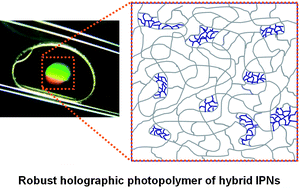We demonstrated that holographic photopolymers of organic/inorganic hybrid interpenetrating networks (IPNs) showed both enhanced monomer diffusion and reduced volume shrinkage, simultaneously. Hybrid IPNs were developed from simple in-situ sol-gel reaction: the alkoxysilane of (3-aminopropyl)triethoxysilane (APTES) leads to the formation of inorganic networks, while simultaneously partial introduction of the two amines of APTES into epoxy resins reduced the overall crosslink density of organic networks. In particular, the morphology of hybrid IPNs can be easily controlled by simply adjusting the ratio of APTES to epoxy resins. When the ratio of APTES to oxirane was 7.0 wt %, interpenetrated hard inorganic networks were homogeneously distributed within soft organic networks without aggregation. The present hybrid IPNs were very effective for high performance holographic properties including diffraction efficiency and volume shrinkage. Soft organic networks with low overall crosslink density enabled fast monomer diffusion for photopolymerization, and consequently diffraction efficiency was enhanced. In addition to fast monomer diffusion, locally dispersed inorganic networks dramatically suppressed the volume shrinkage, due to their filler strengthening effect accompanied by an interpenetrating effect. This synergetic effect of hybrid IPNs allows the enhancement of diffraction efficiency without sacrificing volume shrinkage.

You have access to this article
 Please wait while we load your content...
Something went wrong. Try again?
Please wait while we load your content...
Something went wrong. Try again?


 Please wait while we load your content...
Please wait while we load your content...